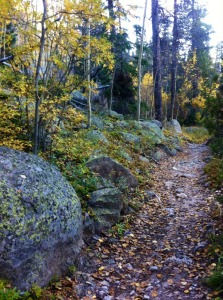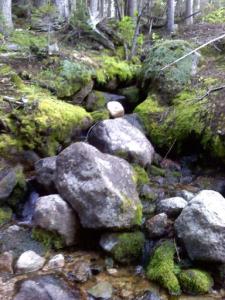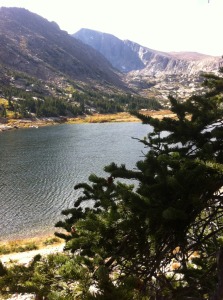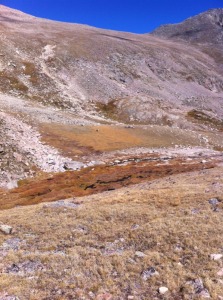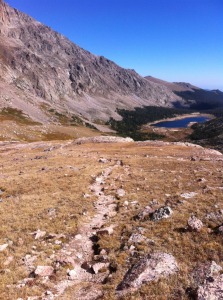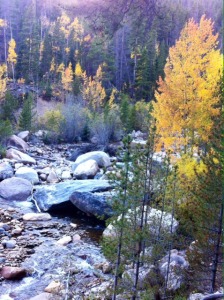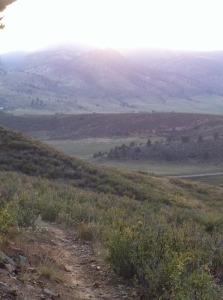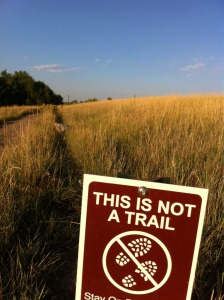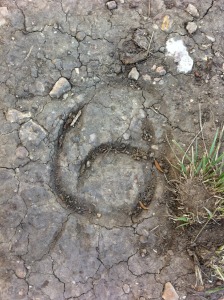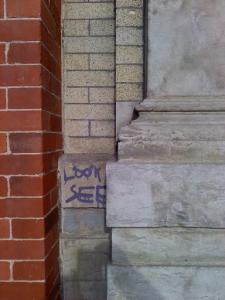Rocky Mountain National Park: going beyond the known
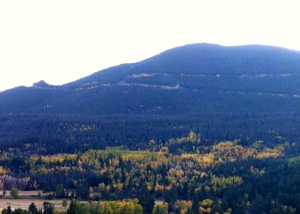 September in Rocky Mountain National Park is a postcard at every turn. If you live along the northern Front Range of the Colorado Rockies, you can drive up the Big Thompson Canyon, through Estes Park, and be saying hello to a park ranger in less than an hour.
September in Rocky Mountain National Park is a postcard at every turn. If you live along the northern Front Range of the Colorado Rockies, you can drive up the Big Thompson Canyon, through Estes Park, and be saying hello to a park ranger in less than an hour.
Hiking here is soothing. On the running trail at home, I listen to the crunch of my feet hitting the dry gravel, kicking loose rocks. Here the way leads up into the deep stillness of the pine and spruce forest. The last of the high snowmelt trickles down little gurgling streams, straight down the mountainside, and where these streams cross the trail, all is wet, mossy, and dark. Long tracks of trail are wet as I climb, my footsteps muffled by pine cones and soft needles, bits of fallen bark and Spanish moss, and aspen leaves strewn like rose petals up the aisle.
Sometimes I run this trail, but today I am hiking, because I want to go farther than usual. The voice of the lower reaches is Roaring River, pounding relentlessly down broken boulders and the very bedrock of the mountain. It still runs wild in autumn, when many Colorado rivers have slowed to almost nothing.
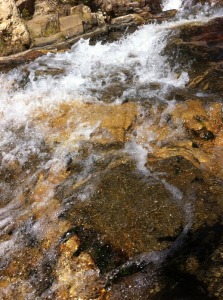 Until this summer, I thought this was the Fall River. I thought I knew. The trailhead is off Fall River Road, this is the river along that trail, and Estes Park is filled with “Fall River” this and that. For 30 years, I thought I was becoming intimately familiar with Fall River, the churning falls seemingly the namesake.
Until this summer, I thought this was the Fall River. I thought I knew. The trailhead is off Fall River Road, this is the river along that trail, and Estes Park is filled with “Fall River” this and that. For 30 years, I thought I was becoming intimately familiar with Fall River, the churning falls seemingly the namesake.
Only, no. Because I never checked the fairly logical assumption I made when I first hiked the Lawn Lake Trail at 18, I have believed – all my adult life – that I knew what I was talking about. I have believed that my logical, rational mind was my most powerful tool.
And so I have believed a myth of my own making.
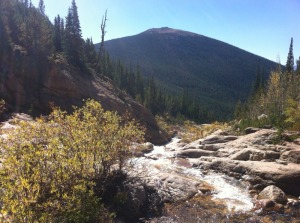 So obvious, now that I know. If any river in Colorado should be named the Roaring River, this one is it. The Roaring River’s banks are ripped high into the side of the mountain, trees toppled in, boulders the size of the ranger’s entrance station huts hanging precariously from the exposed dirt. In the flood of 1982, it tore loose from Lawn Lake and flooded Horseshoe Park and the town of Estes Park. You’d think I would have noticed, maybe listened to the detailed news reports that told how the old earthen dam at Lawn Lake built in 1903 gave way one warm, sunny, summer day, sending all the lake’s water down the Roaring River at 18,000 cubic feet per second. That’s catastrophic: 5,000 cubic ft/sec is a dangerous class 5 rapids. Water literally roared down the river in a 25-foot-tall flood wave. But I was 16 then, listening to American Top 40 on the radio that summer. I didn’t pay attention, and so, I didn’t know.
So obvious, now that I know. If any river in Colorado should be named the Roaring River, this one is it. The Roaring River’s banks are ripped high into the side of the mountain, trees toppled in, boulders the size of the ranger’s entrance station huts hanging precariously from the exposed dirt. In the flood of 1982, it tore loose from Lawn Lake and flooded Horseshoe Park and the town of Estes Park. You’d think I would have noticed, maybe listened to the detailed news reports that told how the old earthen dam at Lawn Lake built in 1903 gave way one warm, sunny, summer day, sending all the lake’s water down the Roaring River at 18,000 cubic feet per second. That’s catastrophic: 5,000 cubic ft/sec is a dangerous class 5 rapids. Water literally roared down the river in a 25-foot-tall flood wave. But I was 16 then, listening to American Top 40 on the radio that summer. I didn’t pay attention, and so, I didn’t know.
There’s so much we think we know…who we are, what is or is not possible, where the edges of the map are and where there be dragons. We create a personal mythology to make sense of our lives, to hold back the floodwaters of chaos and pain, but then the story takes over, and, as Murray Stein says in Facing the Gods, “The individual is unconsciously living a myth rather than a life.” We start losing authentic resonance with new experience. Because we decide we already know how the story goes.
Zen master Suzuki taught a summation of the teachings of Buddhism: “not always so.”
Maybe we should check our assumptions about what is true. Maybe life is bigger than we think. Maybe there’s a whole world out there, happening. Maybe we should find out what we’re talking about.
I made my way to Lawn Lake. But rather than take a break on the grassy flat banks and head back down the trail as usual – I just kept going. At first curious to see the lake-area campsites, I soon realized I was headed not only along the shoreline but up through a wooded rise and past the lake itself. I had found the trail I had seen others on years earlier, high on the mountainside above the lake, a trail I had longed to follow. As I realized where I was headed, I came to a good-sized tree fallen squarely across the path.
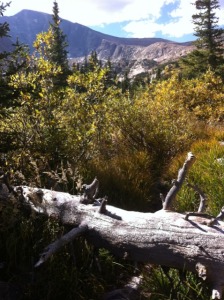 Deliberate though this gate may be, the trail clearly led on beyond it, equally intentional. No signs indicated whether the trail was open or closed. So I decided…that…I don’t know. I looked around me, but I had left everyone else behind. I looked up at the high country ahead. I looked down at the tree trunk. And then I climbed over.
Deliberate though this gate may be, the trail clearly led on beyond it, equally intentional. No signs indicated whether the trail was open or closed. So I decided…that…I don’t know. I looked around me, but I had left everyone else behind. I looked up at the high country ahead. I looked down at the tree trunk. And then I climbed over.
Often I am pragmatic, practical and safety-conscious. But I am “not always so.” While I’m exploring the larger world that’s out there, happening, with or without me, I have to let go my tight hold on what I “know,” if I want to expand my map of the world I live in.
Lawn Lake sits at 11,000 feet, and it was rapidly dwindling below me as I crossed soggy drainages filled with bushy willows as high as my head. Moose habitat, I thought, or elk, and mindfulness was suddenly pragmatic. Beyond the willows, one last stand of gnarled, wind-twisted bristlecone pines ushered me to the tundra above treeline, where dirt trails and rock cairns led to the Crystal Lakes hidden within a massive cirque, or to the Saddle, a relatively smooth pass between peaks.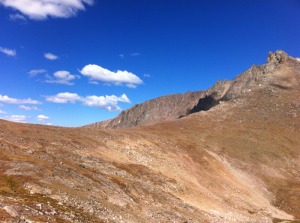 Starting up the saddle trail, I scrambled over boulders, crisscrossing the drainage streams under a cloudless blue sky, the warm sun and cool mountain air exhilarating. Lifting my gaze to the peak above, I climbed from boulder pile to stone outcropping to rock ledge in the thin tundra soil. Soon I was above the saddle, above Crystal Lakes, and on my way toward the top of the mountain.
Starting up the saddle trail, I scrambled over boulders, crisscrossing the drainage streams under a cloudless blue sky, the warm sun and cool mountain air exhilarating. Lifting my gaze to the peak above, I climbed from boulder pile to stone outcropping to rock ledge in the thin tundra soil. Soon I was above the saddle, above Crystal Lakes, and on my way toward the top of the mountain. 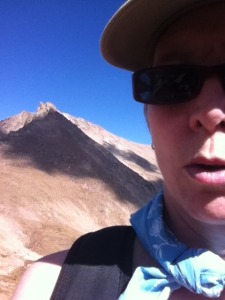
But by now, it was nearly 2:30. Mountain wisdom sends us all down from the high peaks before 2:00, always, and I saw the first clouds rolling over, creating shadows across the mountainsides. Happy to just be here now, I started down, this time toward the Crystal Lakes. I hiked along the rugged clifftops, looking down over the edges here and there at the smooth blue-green pools, the water-carved stone basins undulating like dragons under the surface.
I felt…ancient. Hiking along across tundra and square-bouldered cliffs and watching the changing sky, I felt connected to this immense, silent mountain, huge into the earth beneath me, and to the ancient people who have hiked across similar terrain, all over the world, for millenia. I felt incredibly human. 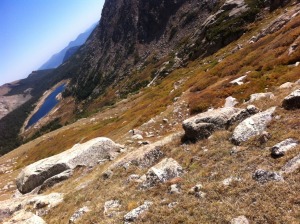
It’s disorienting, too, though. So much of our daily life is spent down low, looking up. Buildings tower over us, bosses stand in the doorway talking with us seated at our desks, trees and hillsides and road signs all require us to crane our necks upward as we pass under. Here I looked above me directly into the immense sky, standing level with the tops of huge mountain peaks. Most of the immediate world lay below me, and standing on the steep slopes viewing the familiar through this unfamiliar lens, my definition of feeling human was stretched in new ways, as well.
Today I had hiked to almost 13,000 feet, higher than the pass between hooked Hagues Peak and Fairchild Mountain, that great cirque enclosing the stone dragons within crystal lakes. I had looked across the top of the 12,541-foot unnamed peak on Lawn Lake’s west shore, and stood face to face with 13,425-foot Mummy Mountain across the lake valley. Facing the gods, in mythology. In reality, facing my own insignificance, vulnerability, and mortality, without a heroic story to cling to. It’s disorienting and unfamiliar to go beyond the known edges of our maps, the world tilting away beneath our feet as we look up into the great unknown above. But this is where we find new meaning, the headwaters of all that sustains us.
“In risking the unknown, we gain a sense of life itself.” — Jack Kornfield, A Path With Heart
I made it down to the trailhead as the elk began bugling into the early twilight. I looked back up at the peaks miles away, listening to the river, wondering at my day. I had stood on the cirque cliffs, where eagles circled. And I soon became painfully aware that I had stood there without sunscreen. Fairchild Mountain indeed. I knew better than to forget the power of the sun at altitude, and winced as I dabbed cold aloe vera gel onto my red neck and shoulders, laughing wryly, “well, not always so.” I had at last traveled the Roaring River.
